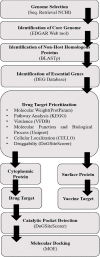Genome-Based Drug Target Identification in Human Pathogen Streptococcus gallolyticus
- PMID: 33841489
- PMCID: PMC8027347
- DOI: 10.3389/fgene.2021.564056
Genome-Based Drug Target Identification in Human Pathogen Streptococcus gallolyticus
Abstract
Streptococcus gallolysticus (Sg) is an opportunistic Gram-positive, non-motile bacterium, which causes infective endocarditis, an inflammation of the inner lining of the heart. As Sg has acquired resistance with the available antibiotics, therefore, there is a dire need to find new therapeutic targets and potent drugs to prevent and treat this disease. In the current study, an in silico approach is utilized to link genomic data of Sg species with its proteome to identify putative therapeutic targets. A total of 1,138 core proteins have been identified using pan genomic approach. Further, using subtractive proteomic analysis, a set of 18 proteins, essential for bacteria and non-homologous to host (human), is identified. Out of these 18 proteins, 12 cytoplasmic proteins were selected as potential drug targets. These selected proteins were subjected to molecular docking against drug-like compounds retrieved from ZINC database. Furthermore, the top docked compounds with lower binding energy were identified. In this work, we have identified novel drug and vaccine targets against Sg, of which some have already been reported and validated in other species. Owing to the experimental validation, we believe our methodology and result are significant contribution for drug/vaccine target identification against Sg-caused infective endocarditis.
Keywords: Streptococcus gallollyticus; drug prioritization; infective endocarditis; pan-genome; subtractive proteomics.
Copyright © 2021 Qureshi, Bakhtiar, Faheem, Shah, Bari, Mahmood, Sohaib, Mothana, Ullah and Jamal.
Conflict of interest statement
The authors declare that the research was conducted in the absence of any commercial or financial relationships that could be construed as a potential conflict of interest.
Figures














Similar articles
-
Integration of molecular docking and molecular dynamics simulations with subtractive proteomics approach to identify the novel drug targets and their inhibitors in Streptococcus gallolyticus.Sci Rep. 2024 Jun 26;14(1):14755. doi: 10.1038/s41598-024-64769-z. Sci Rep. 2024. PMID: 38926437 Free PMC article.
-
Reverse Vaccinology Approach to Identify Novel and Immunogenic Targets against Streptococcus gordonii.Biology (Basel). 2024 Jul 9;13(7):510. doi: 10.3390/biology13070510. Biology (Basel). 2024. PMID: 39056703 Free PMC article.
-
In Silico Subtractive Proteomics and Molecular Docking Approaches for the Identification of Novel Inhibitors against Streptococcus pneumoniae Strain D39.Life (Basel). 2023 May 4;13(5):1128. doi: 10.3390/life13051128. Life (Basel). 2023. PMID: 37240772 Free PMC article.
-
Prioritization of potential drug targets against P. aeruginosa by core proteomic analysis using computational subtractive genomics and Protein-Protein interaction network.Comput Biol Chem. 2018 Jun;74:115-122. doi: 10.1016/j.compbiolchem.2018.02.017. Epub 2018 Mar 8. Comput Biol Chem. 2018. PMID: 29587180
-
Genomics, evolution, and molecular epidemiology of the Streptococcus bovis/Streptococcus equinus complex (SBSEC).Infect Genet Evol. 2015 Jul;33:419-36. doi: 10.1016/j.meegid.2014.09.017. Epub 2014 Sep 16. Infect Genet Evol. 2015. PMID: 25233845 Review.
Cited by
-
Subtractive proteomics and reverse-vaccinology approaches for novel drug targets and designing a chimeric vaccine against Ruminococcus gnavus strain RJX1120.Front Immunol. 2025 Apr 14;16:1555741. doi: 10.3389/fimmu.2025.1555741. eCollection 2025. Front Immunol. 2025. PMID: 40297578 Free PMC article.
-
Integrated Pangenome Analysis and Pharmacophore Modeling Revealed Potential Novel Inhibitors against Enterobacter xiangfangensis.Int J Environ Res Public Health. 2022 Nov 10;19(22):14812. doi: 10.3390/ijerph192214812. Int J Environ Res Public Health. 2022. PMID: 36429532 Free PMC article.
-
In-silico drug design for the novel Karachi-NF001 strain of brain-eating amoeba: Naegleria fowleri.Front Mol Biosci. 2023 Feb 9;10:1098217. doi: 10.3389/fmolb.2023.1098217. eCollection 2023. Front Mol Biosci. 2023. PMID: 36845543 Free PMC article.
-
Structural informatics approach for designing an epitope-based vaccine against the brain-eating Naegleria fowleri.Front Immunol. 2023 Oct 30;14:1284621. doi: 10.3389/fimmu.2023.1284621. eCollection 2023. Front Immunol. 2023. PMID: 37965306 Free PMC article.
-
Genomic and Computational Analysis Unveils Bacteriocin Based Therapeutics against Clinical Mastitis Pathogens in Dairy Cows.Probiotics Antimicrob Proteins. 2025 Apr 29. doi: 10.1007/s12602-025-10563-w. Online ahead of print. Probiotics Antimicrob Proteins. 2025. PMID: 40295467
References
-
- Barh D., Jain N., Tiwari S., Parida B. P., D’Afonseca V., Li L., et al. (2011). A novel comparative genomics analysis for common drug and vaccine targets in Corynebacterium pseudotuberculosis and other CMN group of human pathogens. Chem. Biol. Drug Des. 78 73–84. 10.1111/j.1747-0285.2011.01118.x - DOI - PubMed
LinkOut - more resources
Full Text Sources
Other Literature Sources
Molecular Biology Databases
Research Materials

